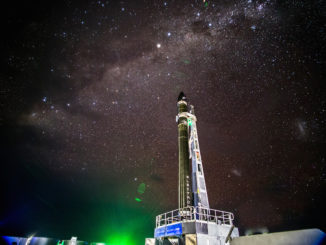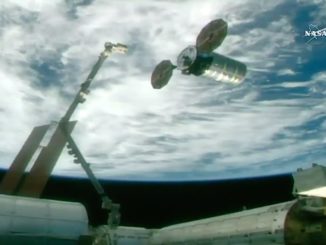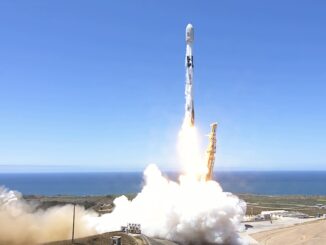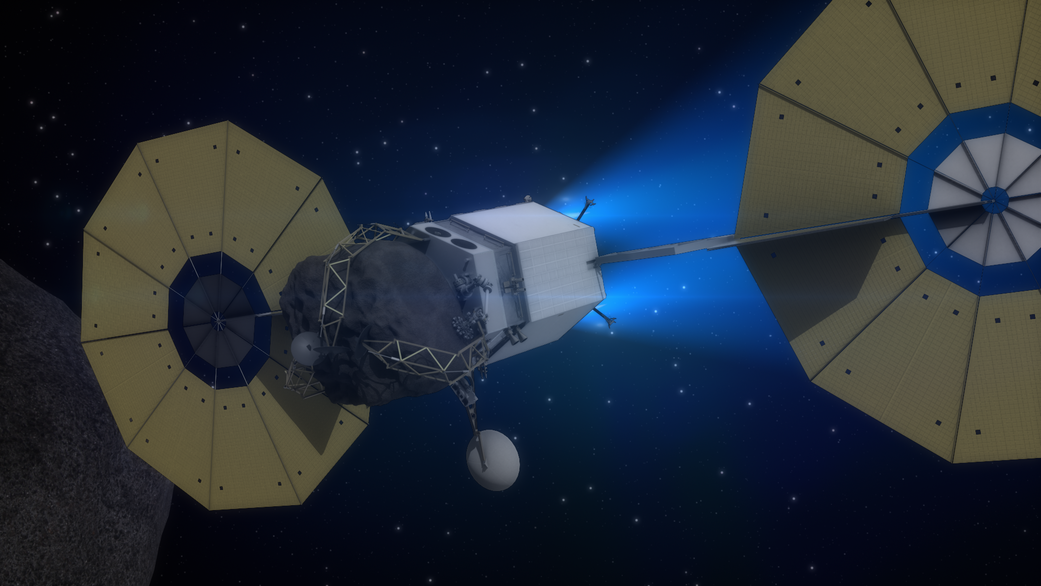
NASA is seeking proposals from U.S. satellite manufacturers interested in building the spacecraft bus for the agency’s initiative to pluck a boulder from an asteroid and drive it into lunar orbit, with plans to select multiple winners for study contracts next year.
That is assuming Congress, which has been lukewarm on the asteroid redirect plan backed by the Obama administration, provides funding to move forward with the program in next year’s budget.
The space agency is interested in ideas from U.S. companies interested in supplying a spacecraft bus for the robotic portion of the Asteroid Redirect Mission, or ARM, which aims to snare a boulder off an asteroid and tow it into orbit around the moon, where astronauts will dock with it and collect samples for return to Earth.
“We’re eager to hear from American companies on their ideas for a spacecraft design that could accommodate our advanced solar electric propulsion requirements and robotic technologies,” said Robert Lightfoot, NASA’s associate administrator. “We’re also interested in what sorts of innovative commercial, international and academic partnerships opportunities might be practical and help reduce overall mission costs while still demonstrating the technologies we need for our journey to Mars.”
The request for proposals, dated Oct. 16, covers the first phase of a two-part procurement strategy for the spacecraft for the Asteroid Redirect Robotic Mission — ARRM — the uncrewed portion of the program.
NASA’s Jet Propulsion Laboratory in California is overseeing the robotic segment of the ARM project.
“The first phase is design work accomplished through studies by U.S. (only) industry toward mission preliminary design,” NASA officials wrote in the request for proposals. “The second phase includes development of the flight spacecraft bus. The solicitation associated with this posting will be for Phase 1, described as conceptual studies for the ARRM spacecraft.”
Brian Muirhead, the ARRM project manager at JPL, said Friday each study team will receive $1 million to work on their concepts through summer 2016, then NASA plans to issue a solicitation for bids to produce the spacecraft itself.
“But that is dependent on appropriations from Congress that will allow ARRM to proceed ahead,” Moorhead said Friday in an online briefing hosted by NASA.
Proposals for the first phase of the spacecraft procurement plan are due Nov. 16.
NASA says the robotic mission, set for launch no earlier than late 2020, will spur development of new technologies needed for eventual human voyages to Mars, such as an advanced solar electric propulsion system with a 20-fold improvement over ion drives flying today. Agency officials also tout the program’s contributions to solar system research and the demonstration of techniques that could steer asteroids away from a collision course with Earth in the future.
The piloted visit to the asteroid, scheduled for December 2025 aboard an Orion space capsule, would prove out crew operations in deep space, including rendezvous, docking and spacewalks, NASA says.
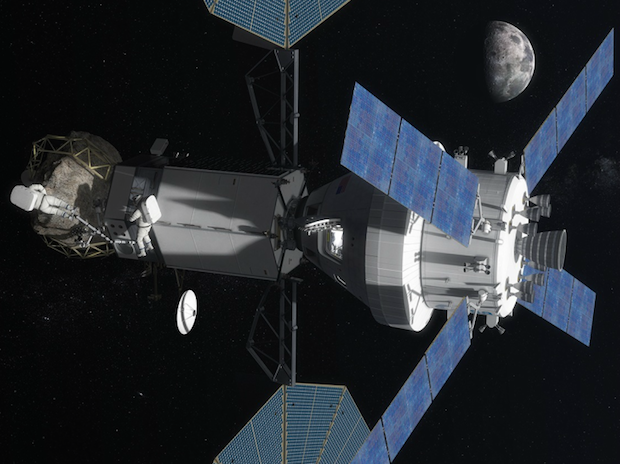
NASA hopes to fund multiple contractor teams — the agency did not specify how many — beginning in January. That timeframe depends on the passage of a new federal budget by Congress, which has until Dec. 11 decide on a new government spending plan.
The government is currently operating on a continuing resolution, a stopgap budget which keeps spending levels at roughly last year’s numbers.
The White House proposed $220 million for the Asteroid Redirect Mission in fiscal year 2016, which began Oct. 1, but many lawmakers have questioned the value of the asteroid initiative, suggesting the technologies and skills to be honed for future Mars expeditions could be tested elsewhere.
The technical requirements for the ARRM spacecraft include an initial solar array power of 50 kilowatts, twice as much as today’s most powerful communications satellites. The craft will also host a robotic capture system with three gripper legs to grab a boulder with a mass of 20 tons or more from the mission’s target asteroid.
NASA has not picked the asteroid mission’s destination, but officials are using asteroid 2008 EV5, a 1,300-foot (400-meter) object, as a reference target.
The solar electric propulsion system — providing a gentle but steady impulse — will drive the spacecraft with the 19-foot (6-meter) boulder back to cislunar space, a broad region around the moon.
“What solar electric propulsion is all about is the conversion of power into thrust through highly efficient use of propellant and continuous acceleration for long durations,” said Andrew Petro, NASA’s program executive for solar electric propulsion, during Friday’s briefing. “What this does in comparison to conventional propulsion that we typically use is it greatly reduces the mass of propellant that has to be carried by the spacecraft, and the mass that has to be launched from Earth.”
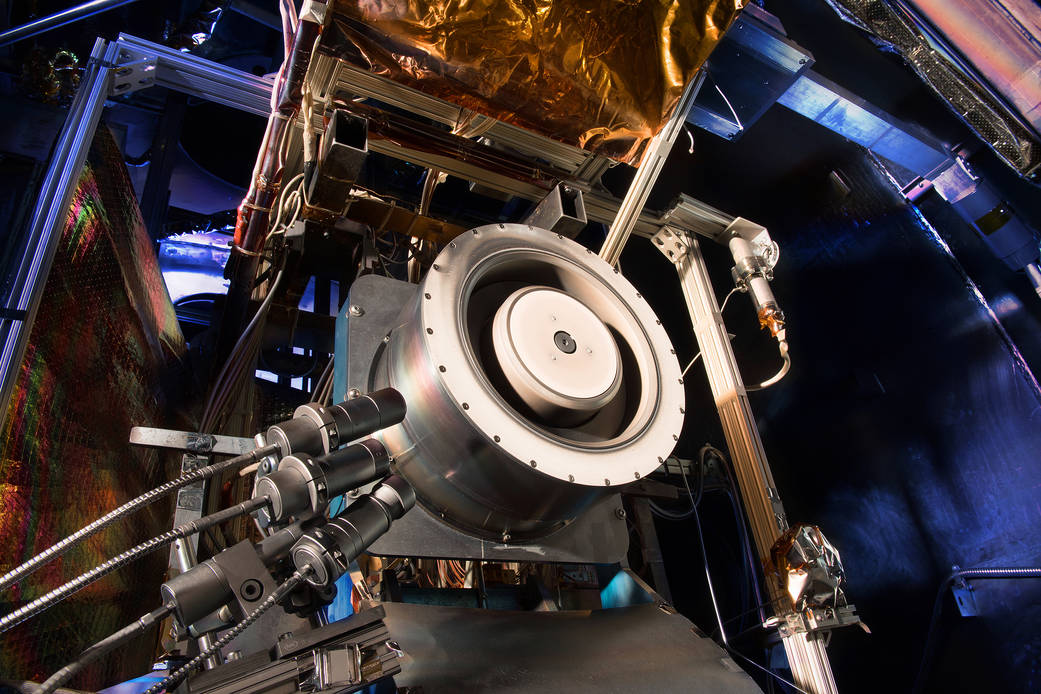
Petro said NASA intends to procure solar electric thrusters from industry under management from NASA’s Glenn Research Center in Ohio. Proposals are already in, and NASA expects to award a contract in early 2016 to build an engineering unit for a solar electric thruster and eventually produce flight units, according to Petro.
“We’re looking at a 50-kilowatt class solar electric propulsion system that would be used to move the spacecraft from the Earth to the asteroid and back again with the asteroid material,” Petro said. “There would be two 25-kilowatt class advanced solar array wings as part of the spacecraft, and long-life 13-kilowatt class electric thruster strings, and about 5 metric tons of xenon propellant that the propulsion system uses.”
Two companies, Orbital ATK and Deployable Space Systems, are developing new solar array designs with higher electricity production capacity, greater strength and more radiation tolerance than existing solar panels.
Before departing the vicinity of the asteroid, the ARRM spacecraft will demonstrate a “gravity tractor” maneuver, using the combined gravitational pull of the spacecraft and the boulder to attempt to slightly alter the trajectory of the body. Such maneuvers could be used to move an asteroid out of the way of Earth if it is deemed a threat to impact the planet.
Once it is parked in lunar orbit, the robotic spacecraft will wait for the arrival of a team of astronauts scheduled for launch aboard NASA’s Space Launch System in 2025.
Steve Stich, director of exploration integration and science at NASA’s Johnson Space Center, said a two-person crew will travel to the ARRM spacecraft in lunar orbit inside an Orion crew capsule. Once there, the astronauts will conduct two spacewalks after docking with the robotic vehicle to document and collect samples from the asteroid fragment.
According to Stich, the first uncrewed test flight of the SLS heavy-lifter and Orion in 2018 will demonstrate the trajectory to be employed on the asteroid rendezvous mission. The 2018 mission, called Exploration Mission-1, will last about 22 days and slingshot around the moon — passing less than 100 miles from the surface — to spiral into a distant retrograde lunar orbit before returning to Earth with a splashdown in the Pacific Ocean.
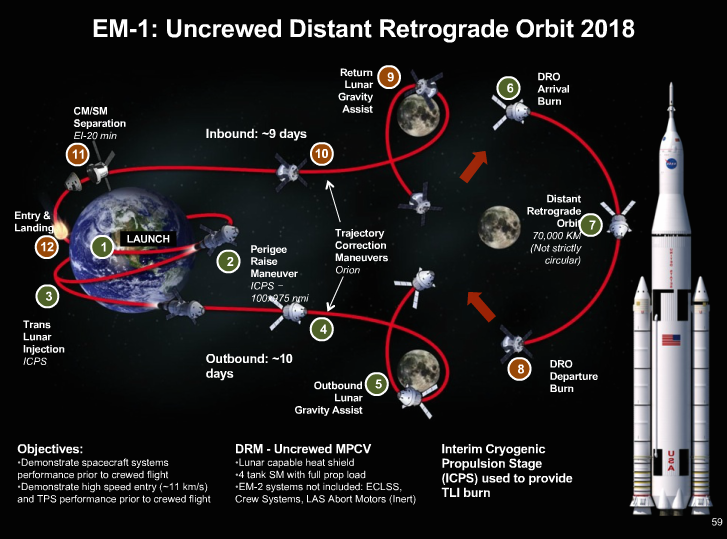
NASA says the automated spacecraft must be ready for launch by December 2020, and it should be sized to fit on either NASA’s Space Launch System or a commercial rocket, such as United Launch Alliance’s Delta 4-Heavy booster or SpaceX’s Falcon Heavy launcher.
The agency intends to spend up to $1.25 billion on the robotic portion of the Asteroid Redirect Mission, excluding the cost of the launch vehicle.
The robotic craft’s xenon fuel tank for its solar-electric rocket thrusters will also have refueling capability so the platform can be repurposed for new missions after the asteroid redirect phase is complete.
Michele Gates, NASA’s program director for the Asteroid Redirect Mission, said Friday that purchasing a commercial satellite bus for the robotic spacecraft will reduce the mission’s cost risk.
Email the author.
Follow Stephen Clark on Twitter: @StephenClark1.

